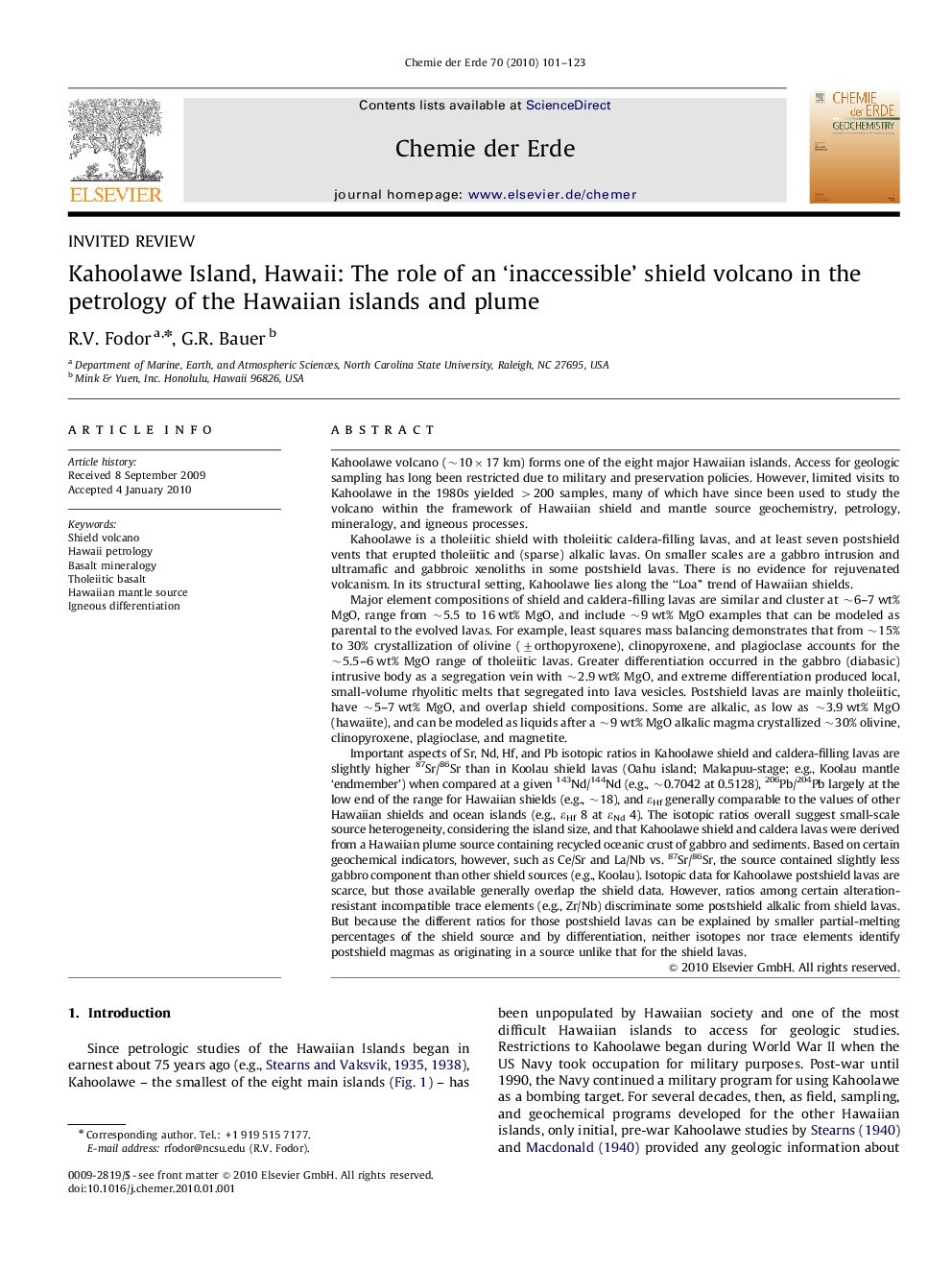| کد مقاله | کد نشریه | سال انتشار | مقاله انگلیسی | نسخه تمام متن |
|---|---|---|---|---|
| 4407057 | 1307343 | 2010 | 23 صفحه PDF | دانلود رایگان |

Kahoolawe volcano (∼10×17 km) forms one of the eight major Hawaiian islands. Access for geologic sampling has long been restricted due to military and preservation policies. However, limited visits to Kahoolawe in the 1980s yielded >200 samples, many of which have since been used to study the volcano within the framework of Hawaiian shield and mantle source geochemistry, petrology, mineralogy, and igneous processes.Kahoolawe is a tholeiitic shield with tholeiitic caldera-filling lavas, and at least seven postshield vents that erupted tholeiitic and (sparse) alkalic lavas. On smaller scales are a gabbro intrusion and ultramafic and gabbroic xenoliths in some postshield lavas. There is no evidence for rejuvenated volcanism. In its structural setting, Kahoolawe lies along the “Loa” trend of Hawaiian shields.Major element compositions of shield and caldera-filling lavas are similar and cluster at ∼6–7 wt% MgO, range from ∼5.5 to 16 wt% MgO, and include ∼9 wt% MgO examples that can be modeled as parental to the evolved lavas. For example, least squares mass balancing demonstrates that from ∼15% to 30% crystallization of olivine (±orthopyroxene), clinopyroxene, and plagioclase accounts for the ∼5.5–6 wt% MgO range of tholeiitic lavas. Greater differentiation occurred in the gabbro (diabasic) intrusive body as a segregation vein with ∼2.9 wt% MgO, and extreme differentiation produced local, small-volume rhyolitic melts that segregated into lava vesicles. Postshield lavas are mainly tholeiitic, have ∼5–7 wt% MgO, and overlap shield compositions. Some are alkalic, as low as ∼3.9 wt% MgO (hawaiite), and can be modeled as liquids after a ∼9 wt% MgO alkalic magma crystallized ∼30% olivine, clinopyroxene, plagioclase, and magnetite.Important aspects of Sr, Nd, Hf, and Pb isotopic ratios in Kahoolawe shield and caldera-filling lavas are slightly higher 87Sr/86Sr than in Koolau shield lavas (Oahu island; Makapuu-stage; e.g., Koolau mantle ‘endmember’) when compared at a given 143Nd/144Nd (e.g., ∼0.7042 at 0.5128), 206Pb/204Pb largely at the low end of the range for Hawaiian shields (e.g., ∼18), and εHf generally comparable to the values of other Hawaiian shields and ocean islands (e.g., εHf 8 at εNd 4). The isotopic ratios overall suggest small-scale source heterogeneity, considering the island size, and that Kahoolawe shield and caldera lavas were derived from a Hawaiian plume source containing recycled oceanic crust of gabbro and sediments. Based on certain geochemical indicators, however, such as Ce/Sr and La/Nb vs. 87Sr/86Sr, the source contained slightly less gabbro component than other shield sources (e.g., Koolau). Isotopic data for Kahoolawe postshield lavas are scarce, but those available generally overlap the shield data. However, ratios among certain alteration-resistant incompatible trace elements (e.g., Zr/Nb) discriminate some postshield alkalic from shield lavas. But because the different ratios for those postshield lavas can be explained by smaller partial-melting percentages of the shield source and by differentiation, neither isotopes nor trace elements identify postshield magmas as originating in a source unlike that for the shield lavas.
Journal: Chemie der Erde - Geochemistry - Volume 70, Issue 2, May–June 2010, Pages 101–123